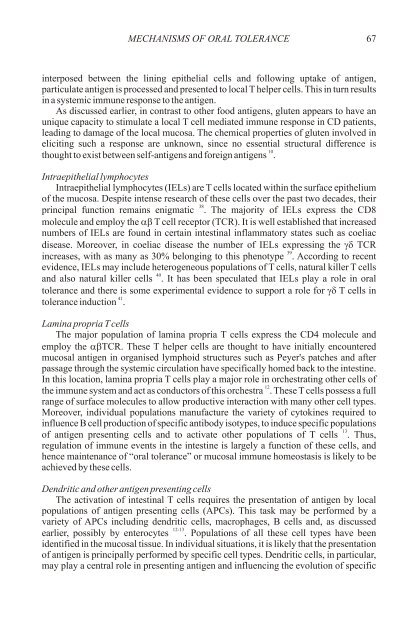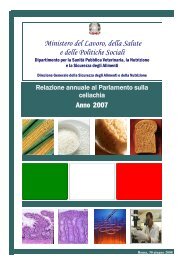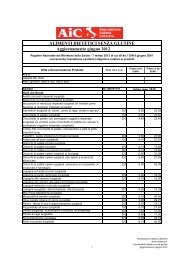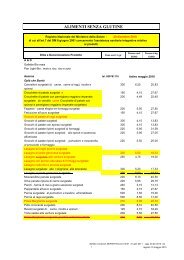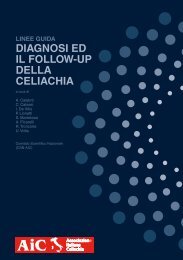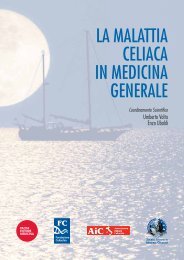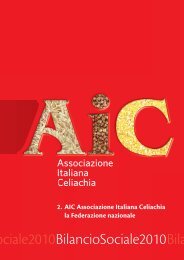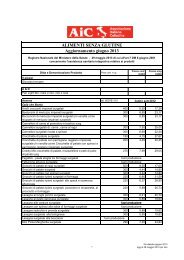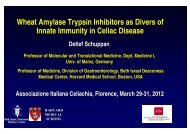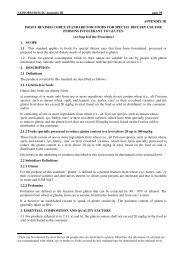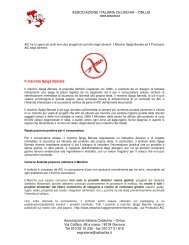primary prevention of coeliac disease - Associazione Italiana ...
primary prevention of coeliac disease - Associazione Italiana ...
primary prevention of coeliac disease - Associazione Italiana ...
You also want an ePaper? Increase the reach of your titles
YUMPU automatically turns print PDFs into web optimized ePapers that Google loves.
MECHANISMS OF ORAL TOLERANCE<br />
67<br />
interposed between the lining epithelial cells and following uptake <strong>of</strong> antigen,<br />
particulate antigen is processed and presented to local T helper cells. This in turn results<br />
in a systemic immune response to the antigen.<br />
As discussed earlier, in contrast to other food antigens, gluten appears to have an<br />
unique capacity to stimulate a local T cell mediated immune response in CD patients,<br />
leading to damage <strong>of</strong> the local mucosa. The chemical properties <strong>of</strong> gluten involved in<br />
eliciting such a response are unknown, since no essential structural difference is<br />
10<br />
thought to exist between self-antigens and foreign antigens .<br />
Intraepithelial lymphocytes<br />
Intraepithelial lymphocytes (IELs) are T cells located within the surface epithelium<br />
<strong>of</strong> the mucosa. Despite intense research <strong>of</strong> these cells over the past two decades, their<br />
38<br />
principal function remains enigmatic . The majority <strong>of</strong> IELs express the CD8<br />
molecule and employ the abT cell receptor (TCR). It is well established that increased<br />
numbers <strong>of</strong> IELs are found in certain intestinal inflammatory states such as <strong>coeliac</strong><br />
<strong>disease</strong>. Moreover, in <strong>coeliac</strong> <strong>disease</strong> the number <strong>of</strong> IELs expressing the gdTCR<br />
39<br />
increases, with as many as 30% belonging to this phenotype . According to recent<br />
evidence, IELs may include heterogeneous populations <strong>of</strong> T cells, natural killer T cells<br />
40<br />
and also natural killer cells . It has been speculated that IELs play a role in oral<br />
tolerance and there is some experimental evidence to support a role for gdT cells in<br />
41<br />
tolerance induction .<br />
Lamina propria T cells<br />
The major population <strong>of</strong> lamina propria T cells express the CD4 molecule and<br />
employ the abTCR. These T helper cells are thought to have initially encountered<br />
mucosal antigen in organised lymphoid structures such as Peyer's patches and after<br />
passage through the systemic circulation have specifically homed back to the intestine.<br />
In this location, lamina propria T cells play a major role in orchestrating other cells <strong>of</strong><br />
12<br />
the immune system and act as conductors <strong>of</strong> this orchestra . These T cells possess a full<br />
range <strong>of</strong> surface molecules to allow productive interaction with many other cell types.<br />
Moreover, individual populations manufacture the variety <strong>of</strong> cytokines required to<br />
influence B cell production <strong>of</strong> specific antibody isotypes, to induce specific populations<br />
13<br />
<strong>of</strong> antigen presenting cells and to activate other populations <strong>of</strong> T cells . Thus,<br />
regulation <strong>of</strong> immune events in the intestine is largely a function <strong>of</strong> these cells, and<br />
hence maintenance <strong>of</strong> “oral tolerance” or mucosal immune homeostasis is likely to be<br />
achieved by these cells.<br />
Dendritic and other antigen presenting cells<br />
The activation <strong>of</strong> intestinal T cells requires the presentation <strong>of</strong> antigen by local<br />
populations <strong>of</strong> antigen presenting cells (APCs). This task may be performed by a<br />
variety <strong>of</strong> APCs including dendritic cells, macrophages, B cells and, as discussed<br />
12-13<br />
earlier, possibly by enterocytes . Populations <strong>of</strong> all these cell types have been<br />
identified in the mucosal tissue. In individual situations, it is likely that the presentation<br />
<strong>of</strong> antigen is principally performed by specific cell types. Dendritic cells, in particular,<br />
may play a central role in presenting antigen and influencing the evolution <strong>of</strong> specific


